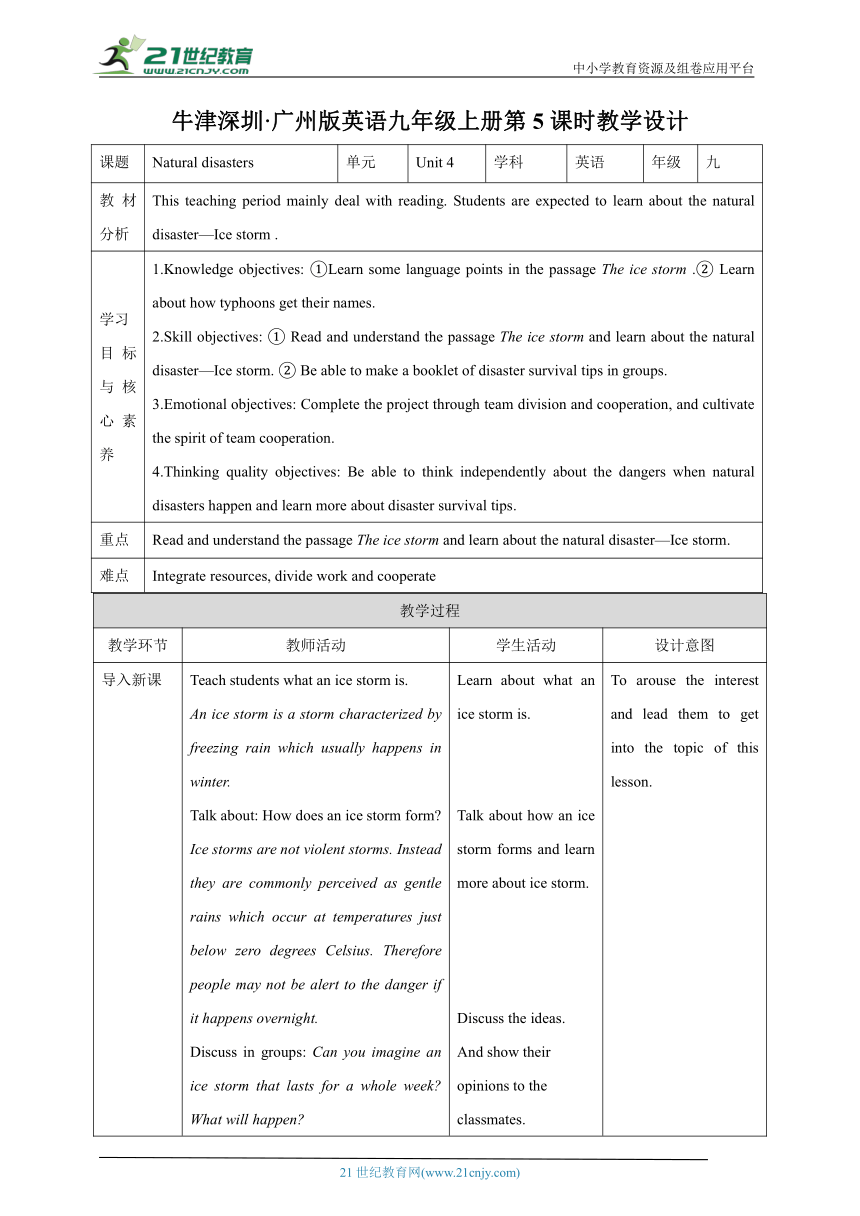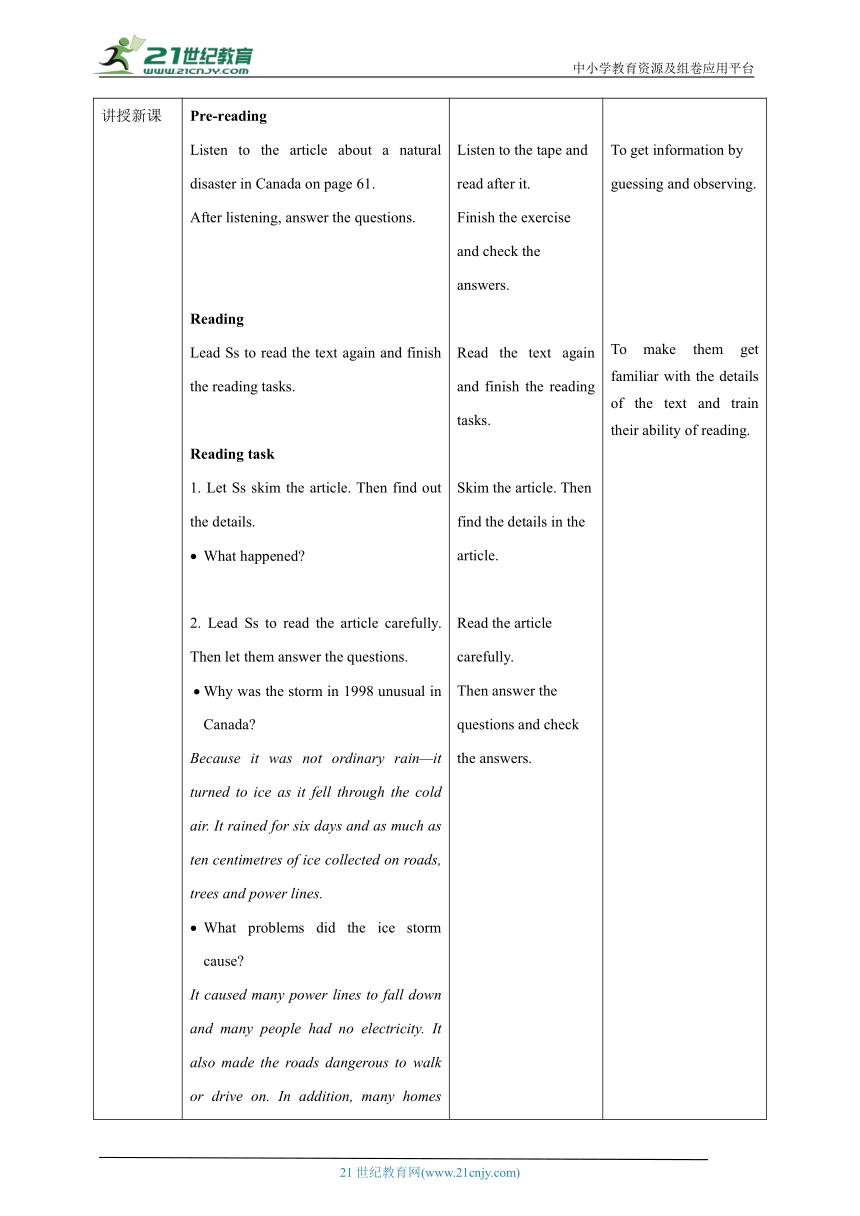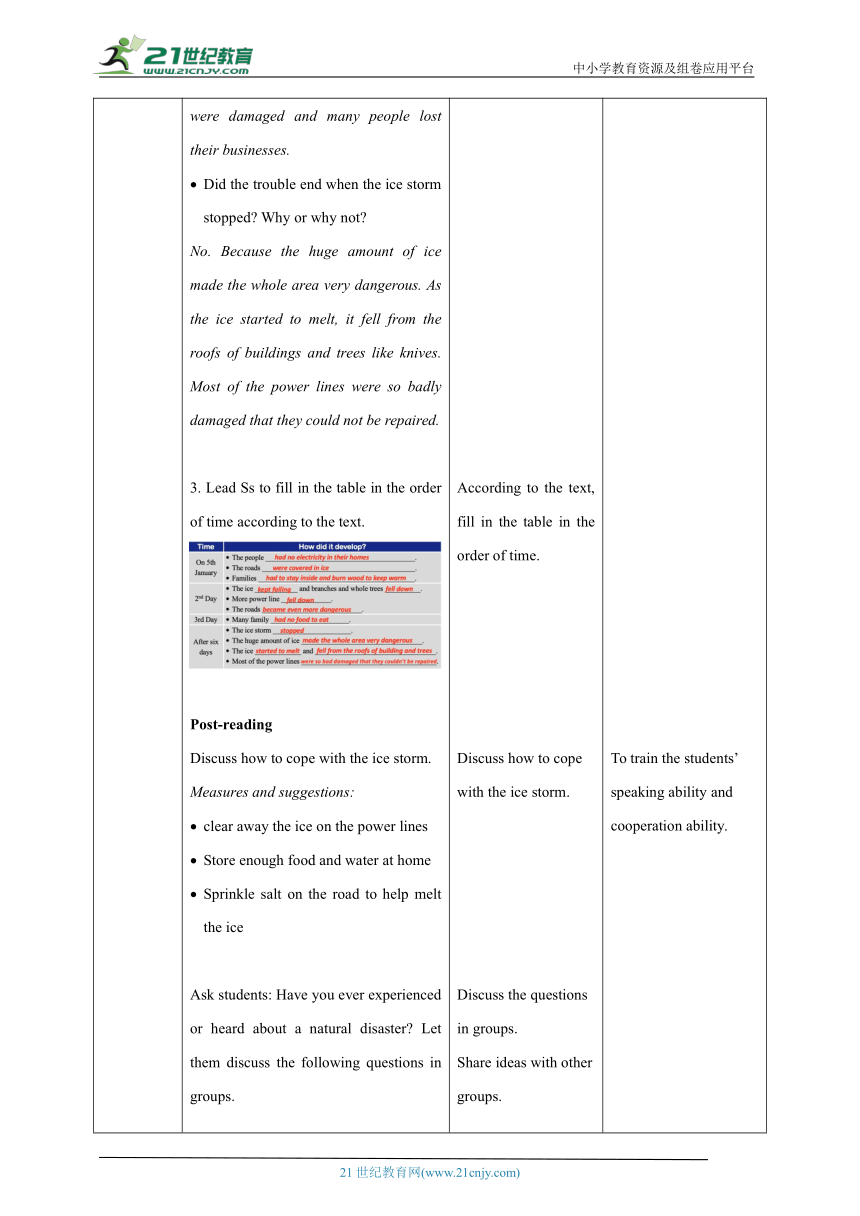【核心素养目标】Unit 4 Natural disasters 第5课时More practice, Culture corner & Project 教案
文档属性
| 名称 | 【核心素养目标】Unit 4 Natural disasters 第5课时More practice, Culture corner & Project 教案 |

|
|
| 格式 | doc | ||
| 文件大小 | 1.3MB | ||
| 资源类型 | 试卷 | ||
| 版本资源 | 牛津深圳版 | ||
| 科目 | 英语 | ||
| 更新时间 | 2023-02-01 16:08:06 | ||
图片预览



文档简介
中小学教育资源及组卷应用平台
课题 Natural disasters 单元 Unit 4 学科 英语 年级 九
教材分析 This teaching period mainly deal with reading. Students are expected to learn about the natural disaster—Ice storm .
学习目标与核心素养 1.Knowledge objectives: ①Learn some language points in the passage The ice storm .② Learn about how typhoons get their names.2.Skill objectives: ① Read and understand the passage The ice storm and learn about the natural disaster—Ice storm. ② Be able to make a booklet of disaster survival tips in groups.3.Emotional objectives: Complete the project through team division and cooperation, and cultivate the spirit of team cooperation.4.Thinking quality objectives: Be able to think independently about the dangers when natural disasters happen and learn more about disaster survival tips.
重点 Read and understand the passage The ice storm and learn about the natural disaster—Ice storm.
难点 Integrate resources, divide work and cooperate
牛津深圳·广州版英语九年级上册第5课时教学设计
教学过程
教学环节 教师活动 学生活动 设计意图
导入新课 Teach students what an ice storm is.An ice storm is a storm characterized by freezing rain which usually happens in winter.Talk about: How does an ice storm form Ice storms are not violent storms. Instead they are commonly perceived as gentle rains which occur at temperatures just below zero degrees Celsius. Therefore people may not be alert to the danger if it happens overnight.Discuss in groups: Can you imagine an ice storm that lasts for a whole week What will happen Learn about what an ice storm is.Talk about how an ice storm forms and learn more about ice storm.Discuss the ideas.And show their opinions to the classmates. To arouse the interest and lead them to get into the topic of this lesson.
讲授新课 Pre-readingListen to the article about a natural disaster in Canada on page 61.After listening, answer the questions.ReadingLead Ss to read the text again and finish the reading tasks.Reading task1. Let Ss skim the article. Then find out the details.What happened 2. Lead Ss to read the article carefully. Then let them answer the questions.Why was the storm in 1998 unusual in Canada Because it was not ordinary rain—it turned to ice as it fell through the cold air. It rained for six days and as much as ten centimetres of ice collected on roads, trees and power lines.What problems did the ice storm cause It caused many power lines to fall down and many people had no electricity. It also made the roads dangerous to walk or drive on. In addition, many homes were damaged and many people lost their businesses.Did the trouble end when the ice storm stopped Why or why not No. Because the huge amount of ice made the whole area very dangerous. As the ice started to melt, it fell from the roofs of buildings and trees like knives. Most of the power lines were so badly damaged that they could not be repaired.3. Lead Ss to fill in the table in the order of time according to the text.Post-readingDiscuss how to cope with the ice storm.Measures and suggestions:clear away the ice on the power linesStore enough food and water at homeSprinkle salt on the road to help melt the iceAsk students: Have you ever experienced or heard about a natural disaster Let them discuss the following questions in groups.What was the natural disaster like What did people experience during the disaster Language pointsLead the Ss to learn the language points.1. expect的用法2. keep doing sth.3. cause sb./sth. to do sth.4. even + 比较级5. make sth. dangerous6. one的用法Let’s doFinish the exercise.Summarize the key words and phrases.Key phrases: turn to, wake up, expect…to do…, at any time, fall down, so…thatCulture cornerShow students some pictures about typhoons and tell them the names of these typhoons.Ask: Do you know how typhoons get their names Lead Ss to read the article and look at the picture on page 62. Then answer the questions.How did countries name typhoons in the old days When did people agree on one system for naming typhoons How many countries and regions offered the typhoons’ names Where do the names always come from How many names for typhoons are there When the names are used up, what will happen Lead Ss to do an extensive reading.ProjectLead students read the introduction and learn about the task of the project: Make a booklet of disaster survival tips.Each group should choose a kind of a natural disaster and discuss what dangers may happen when a natural disaster happens. According to the example, each group should do research on how to survive the kind of natural disaster that they have chosen. Based on your research, think of at least five tips and write them on a piece of paper. Find some photos to go with your work. After each group is done, put all the pages together and make a booklet of tips on surviving a natural disaster. Listen to the tape and read after it.Finish the exercise and check the answers.Read the text again and finish the reading tasks.Skim the article. Then find the details in the article.Read the article carefully. Then answer the questions and check the answers.According to the text, fill in the table in the order of time.Discuss how to cope with the ice storm.Discuss the questions in groups.Share ideas with other groups.Learn some language points and take notes.Finish the exercise and check the answers.Review the key words and phrases.See some pictures about typhoons and learn the names of these typhoons.Think: How do typhoons get their names.Read the article and look at the picture on page 62. Then answer the questions.Do an extensive reading comprehension.Read the introduction and learn about the task of the project.Each group follow the steps to finish the project.After each group is done, put all the pages together and make a booklet of tips on surviving a natural disaster. To get information by guessing and observing.To make them get familiar with the details of the text and train their ability of reading.To train the students’ speaking ability and cooperation ability.To conclude the usage of the key points of the text.To get familiar with the key points by doing exercise.To consolidate what they have learnt.To arouse the interest and lead them to get into the topic of this lesson.To open students’ eyes.To make them get familiar with how typhoons get their names.To open students’ eyes.To arouse the interest and lead them to know what project they will do.To train the students’ speaking ability and cooperation ability.
课堂小结 本课阅读了一篇关于加拿大冰暴的文章,讨论冰暴这一自然灾害对人类的影响。同时,学生也了解了台风命名的方法。最后要求学生以小组为单位,利用书籍或网络搜集各种自然灾害发生时的生存技巧,并为该自然灾害设计制作一份逃生法则。
板书 Key phrases: turn to, wake up, expect…to do…, at any time, fall down, so…that
21世纪教育网 www.21cnjy.com 精品试卷·第 2 页 (共 2 页)
HYPERLINK "http://www.21cnjy.com/" 21世纪教育网(www.21cnjy.com)
课题 Natural disasters 单元 Unit 4 学科 英语 年级 九
教材分析 This teaching period mainly deal with reading. Students are expected to learn about the natural disaster—Ice storm .
学习目标与核心素养 1.Knowledge objectives: ①Learn some language points in the passage The ice storm .② Learn about how typhoons get their names.2.Skill objectives: ① Read and understand the passage The ice storm and learn about the natural disaster—Ice storm. ② Be able to make a booklet of disaster survival tips in groups.3.Emotional objectives: Complete the project through team division and cooperation, and cultivate the spirit of team cooperation.4.Thinking quality objectives: Be able to think independently about the dangers when natural disasters happen and learn more about disaster survival tips.
重点 Read and understand the passage The ice storm and learn about the natural disaster—Ice storm.
难点 Integrate resources, divide work and cooperate
牛津深圳·广州版英语九年级上册第5课时教学设计
教学过程
教学环节 教师活动 学生活动 设计意图
导入新课 Teach students what an ice storm is.An ice storm is a storm characterized by freezing rain which usually happens in winter.Talk about: How does an ice storm form Ice storms are not violent storms. Instead they are commonly perceived as gentle rains which occur at temperatures just below zero degrees Celsius. Therefore people may not be alert to the danger if it happens overnight.Discuss in groups: Can you imagine an ice storm that lasts for a whole week What will happen Learn about what an ice storm is.Talk about how an ice storm forms and learn more about ice storm.Discuss the ideas.And show their opinions to the classmates. To arouse the interest and lead them to get into the topic of this lesson.
讲授新课 Pre-readingListen to the article about a natural disaster in Canada on page 61.After listening, answer the questions.ReadingLead Ss to read the text again and finish the reading tasks.Reading task1. Let Ss skim the article. Then find out the details.What happened 2. Lead Ss to read the article carefully. Then let them answer the questions.Why was the storm in 1998 unusual in Canada Because it was not ordinary rain—it turned to ice as it fell through the cold air. It rained for six days and as much as ten centimetres of ice collected on roads, trees and power lines.What problems did the ice storm cause It caused many power lines to fall down and many people had no electricity. It also made the roads dangerous to walk or drive on. In addition, many homes were damaged and many people lost their businesses.Did the trouble end when the ice storm stopped Why or why not No. Because the huge amount of ice made the whole area very dangerous. As the ice started to melt, it fell from the roofs of buildings and trees like knives. Most of the power lines were so badly damaged that they could not be repaired.3. Lead Ss to fill in the table in the order of time according to the text.Post-readingDiscuss how to cope with the ice storm.Measures and suggestions:clear away the ice on the power linesStore enough food and water at homeSprinkle salt on the road to help melt the iceAsk students: Have you ever experienced or heard about a natural disaster Let them discuss the following questions in groups.What was the natural disaster like What did people experience during the disaster Language pointsLead the Ss to learn the language points.1. expect的用法2. keep doing sth.3. cause sb./sth. to do sth.4. even + 比较级5. make sth. dangerous6. one的用法Let’s doFinish the exercise.Summarize the key words and phrases.Key phrases: turn to, wake up, expect…to do…, at any time, fall down, so…thatCulture cornerShow students some pictures about typhoons and tell them the names of these typhoons.Ask: Do you know how typhoons get their names Lead Ss to read the article and look at the picture on page 62. Then answer the questions.How did countries name typhoons in the old days When did people agree on one system for naming typhoons How many countries and regions offered the typhoons’ names Where do the names always come from How many names for typhoons are there When the names are used up, what will happen Lead Ss to do an extensive reading.ProjectLead students read the introduction and learn about the task of the project: Make a booklet of disaster survival tips.Each group should choose a kind of a natural disaster and discuss what dangers may happen when a natural disaster happens. According to the example, each group should do research on how to survive the kind of natural disaster that they have chosen. Based on your research, think of at least five tips and write them on a piece of paper. Find some photos to go with your work. After each group is done, put all the pages together and make a booklet of tips on surviving a natural disaster. Listen to the tape and read after it.Finish the exercise and check the answers.Read the text again and finish the reading tasks.Skim the article. Then find the details in the article.Read the article carefully. Then answer the questions and check the answers.According to the text, fill in the table in the order of time.Discuss how to cope with the ice storm.Discuss the questions in groups.Share ideas with other groups.Learn some language points and take notes.Finish the exercise and check the answers.Review the key words and phrases.See some pictures about typhoons and learn the names of these typhoons.Think: How do typhoons get their names.Read the article and look at the picture on page 62. Then answer the questions.Do an extensive reading comprehension.Read the introduction and learn about the task of the project.Each group follow the steps to finish the project.After each group is done, put all the pages together and make a booklet of tips on surviving a natural disaster. To get information by guessing and observing.To make them get familiar with the details of the text and train their ability of reading.To train the students’ speaking ability and cooperation ability.To conclude the usage of the key points of the text.To get familiar with the key points by doing exercise.To consolidate what they have learnt.To arouse the interest and lead them to get into the topic of this lesson.To open students’ eyes.To make them get familiar with how typhoons get their names.To open students’ eyes.To arouse the interest and lead them to know what project they will do.To train the students’ speaking ability and cooperation ability.
课堂小结 本课阅读了一篇关于加拿大冰暴的文章,讨论冰暴这一自然灾害对人类的影响。同时,学生也了解了台风命名的方法。最后要求学生以小组为单位,利用书籍或网络搜集各种自然灾害发生时的生存技巧,并为该自然灾害设计制作一份逃生法则。
板书 Key phrases: turn to, wake up, expect…to do…, at any time, fall down, so…that
21世纪教育网 www.21cnjy.com 精品试卷·第 2 页 (共 2 页)
HYPERLINK "http://www.21cnjy.com/" 21世纪教育网(www.21cnjy.com)
